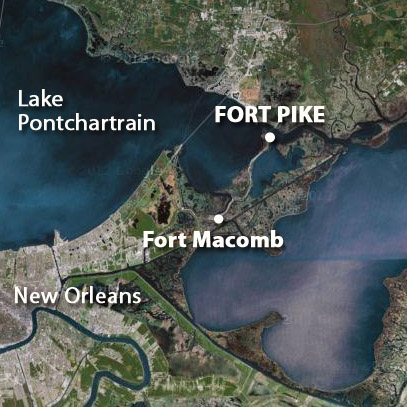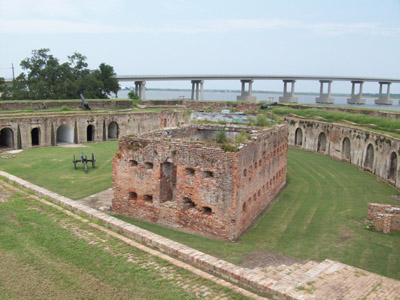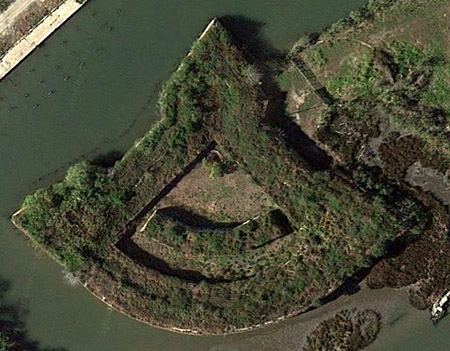 |
Fort Pike
New Orleans, Louisiana, USA
|
|
 |
Constructed: 1819-1826
Used by: USA, CSA
Conflict in which it participated: US Civil War
Designed by: Simon Bernard
|
So as we all know by now if we've been paying attention, the British sailed up the Potomac River during the War of 1812 (1812-1814) and, with very little in the way of interference, torched Washington DC. This had the effect one might expect on America's governing body: An understandably pants-wetting realization that we were practically defenseless against any determined foe with a naval capability.
US President James Madison (1751-1836) launched the US' Third System of seacoast fortification in 1816.
|
 |
 |
|
Some 200 locations along the Atlantic and Gulf coasts were identified as being in desperate need of fortification, and New Orleans was one of the first to receive the attention of the US Army's Corps of Engineers. La Nouvelle-Orléans was founded in 1718 by a commercial entity known as the French Mississippi Company. The United States lovingly embraced New Orleans as part of the Louisiana Purchase (1803), bringing into the fold what instantly became the largest city in the southern US. Nawlins' ports supplied enormous loads of stuff that was shipped up the Mississippi River to the rest of the country, making it an awfully tempting target for any who might wish the United States ill. Fort Pike, one of several things named for recently-killed American hero Zebulon Pike (1779-1813), was begun in 1819 and completed in 1826. Read more about the fort's namesake on our Fort York page, as 'twas during the attack on Fort York that ole Zebulon died in his heroic fashion. The fort of our current interest was designed by Simon Bernard (1779-1839), a French general of engineers who had been kicked out of France when Napoleon (1769-1821) came to power. Bernard is a man to be admired by all starfort fans, as he also designed the fantabulous Fort Monroe in Virginia and Fort Morgan at Mobile Bay in Alabama, among several others. |
 Fort Pike's citadel. Reportedly, Fort Pike and Fort Macomb are the only two forts in the US whose original citadels remain intact. Ahem, might I point to those of Fort Mifflin and Fort Trumbull? Watch yourself when you make such claims, starforts. |
 |
There are three ways for a naval force to get to New Orleans. Sailing up the Mississippi would make for a lengthy and easily-deterred voyage, but entering Lake Pontchartrain via either the charmingly-named Rigolets Pass or the annoyingly-named Chef Menteur Pass would allow the attacker much easier access to the city. It was for this reason that Fort Pike was built to defend the Rigolets.
During the Second Seminole War (1835-1842), Fort Pike was used as a staging area for troops being sent to Florida when the Seminole Indians, having politely been asked to relocate, just as politely refused. After plenty of shooting, stabbing and dying of disease, the Indians left standing were bribed into surrendering, and the red man and the white man lived in mutually respectful harmony for the rest of time.
|
|
|
During this conflict, Fort Pike was used as a collection point for several hundred Seminoles and their black slaves (Slavery: So awesome, even the noble Indians did it!), who were being shuttled from Florida to their convenient new homes in Oklahoma. Some of the fort's guns were removed from their casemates in order to make room for the prisoners.
Fort Pike was built to be manned by a garrison of 400 or so, a number of men that was only ever stationed there for relatively brief periods in wartime. In peacetime or semipeacetime, the garrison was generally 80, but often just a single ordnance sergeant lived at the fort as a caretaker. At one point during the Seminole Wars, 66 US soldiers at Fort Pike guarded over 250 Seminoles and their slaves.
|
Fort Pike was fully manned during the Mexican-American War (1846-1848), and was again used as a staging area, this time for troops on their way to smite the wicked Mexicans. The Mexicans were duly smited (Smitten? Smote?) and Fort Pike's single ordnance sergeant resumed his lonely vigil.
Abraham Lincoln (1809-1865) was elected to be the 16th US president in 1860. This caused great fury in the southern states of the US, who viewed Lincoln as the man who would radically alter their sacred way of life: These states then greatly hastened the end of their peculiar institution by seceding from the union.
|
 |
Fort Pike's moat at low tide. Gosh that single caretaker sergeant was messy! |
|
Louisiana was the sixth state to secede, which it did on January 26 1861. On January 10 1861, however, the Louisiana Continental Guard took control of Fort Pike. If the Louisiana Continental Guard was anything like the Confederate troops who took over the Castillo de San Marcos at St. Augustine Florida at around the same time, the US ordnance sergeant who had been at Fort Pike was likely sent on his way without so much as slightly hurt feelings. The Confederacy possessed Fort Pike for just under four months. Most of the fort's garrison was sent to bolster the Confederate presence at Vicksburg, Mississippi. Sneaky federal troops took advantage of their absence and took the fort (and the rest of New Orleans) back on May 10, 1862...and the rebel ex-garrison of Fort Pike must have been doubly chagrined when Vicksburg was lost to the Union anyway, on July 4 1863.
|
|
 |
The Union used Fort Pike not only as a base of operations for raids along the Gulf coast, but also as a training facility for "colored" (which means black) troops, who were trained in the art of artillery, which doubtless pleased the gentlemen of the Confederacy. These former slaves became part of the United States Colored Troops, who would go on to serve heroically at the disgusting mess that was the Battle of the Crater (July 30 1864), during the Federal siege of Petersburg.
After the war, US troops hung around Louisiana until 1871, just to make quite certain that nobody got up to anything even remotely Confederatey. Fort Pike was left to its single caretaker sergeant again, then turned over to the Quartermaster in 1884 for "disposal." Disposal was obviously deemed to be too much trouble, so the military just abandoned Fort Pike in 1890. Louisiana officially took possession in 1928, and in 1972 the fort was placed on the National Register of Historic Places.
By 2005, Fort Pike was already getting pretty crumbly, when along came Hurricane Katrina. The storm not only killed over 1800 people, most of whom were in New Orleans, but completely submerged Fort Pike.
|
|
|
The fort was reopened to visitors in May of 2008, and along came Hurricane Gustav that September. The fort was reopened in June of 2009 and undergoing extensive repairs when...along came Hurricane Isaac in August of 2012. Today, Fort Pike is indefinitely closed, as it has been so damaged by these storms that it's unsafe for visitors, which makes me very unhappy indeed. Recent pictures show enormous cracks in some of the outer walls. And it seems a foregone conclusion that there will be more hurricanes. No cannon was ever fired in anger at Fort Pike, but it served its role admirably, keeping America's foes from New Orleans and supporting various military adventures in the region. One hopes that Louisiana can find the time and money to repair and reopen the fort to tourism, but it seems likely that the major effort will continue to be repairing and reopening New Orleans! 2016 Update: At the present time, Fort Pike is open to visitors on Fridays, from 9am to 5pm. This occurs solely due to the good nature of one heroic Louisiana State Park Ranger, who agreed to be onsite one day per week. I learned of this quite by accident before heading to the Gulf Coast in May of 2016, and was fortunate enough to get there when the fort was open! Please click here to see pictures of my visit to Fort Pike! |
As Fort Pike protected the Rigolets Pass 10 miles to the north, Fort Macomb protected the Chef Menteur Pass, another means by which an attacking navy might gain entrance to Lake Pontchartrain.
Also designed by Simon Bernard, Fort Chef Menteur was built in 1822 as a companion to Fort Pike. Renamed Fort Wood in 1827, the fort finally got its present name in 1851, named for Alexander Macomb (1782-1841), commanding general of the US Army from 1828 until his death. Macomb had been the hero of the Battle of Plattsburg during the War of 1812, in which he ran circles around a British force that outnumbered his command by nearly 10 to 1.
|
 |
 Look familiar? Fort Macomb, slightly smaller but equally as pointy Look familiar? Fort Macomb, slightly smaller but equally as pointy |
|
Confederate forces captured Fort Macomb on January 14, 1861, just prior to Louisiana's secession from the Union, and Union forces took it back on August 16, 1862. The fort's barracks caught fire and was largely destroyed in 1867, but it remained lightly garrisoned until 1871 when Federal troops left Louisiana. Some effort was made to open Fort Macomb to tourism, but it was determined that nobody wanted to break their neck while scrambling about on this highly deteriorated structure, plus the larger and cooler Fort Pike was close by, and in much better condition. Today, Fort Macomb is closed to visitors, but likely houses a garrison of martial alligators. 2016 Update: No, it doesn't. Or if there are any alligators garrisoning Fort Macomb, they did an excellent job of making themselves scarce when I somewhat surreptitiously visited the fort in May of 2016. Please click here to see pictures of my visit to Fort Macomb!
|
|
|
|
|
|
 |




